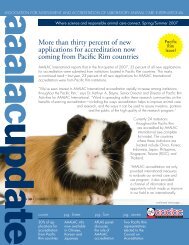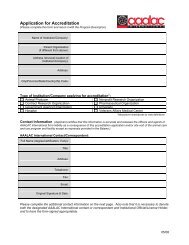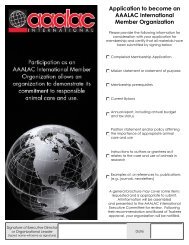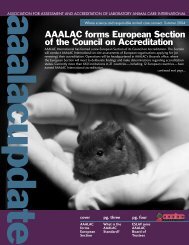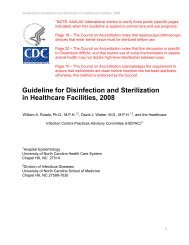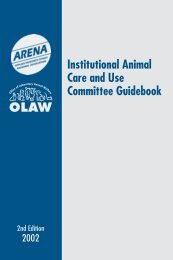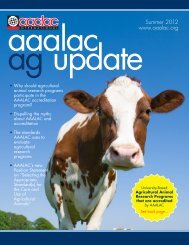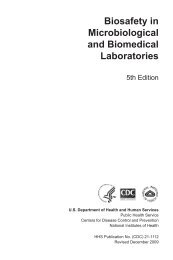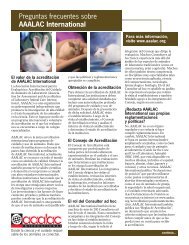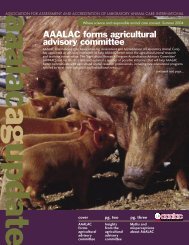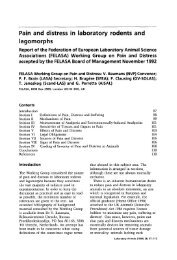Guidelines for Biosafety Laboratory Competency - Centers for ...
Guidelines for Biosafety Laboratory Competency - Centers for ...
Guidelines for Biosafety Laboratory Competency - Centers for ...
Create successful ePaper yourself
Turn your PDF publications into a flip-book with our unique Google optimized e-Paper software.
SupplementCONTENTSIntroduction.............................................................................................................1Purpose..................................................................................................................1Background..........................................................................................................2Methodology...........................................................................................................2Validation Process..............................................................................................2Guiding Principles.................................................................................................3Culture of Safety.................................................................................................3Scope......................................................................................................................4Broad Application..............................................................................................4Competencies and Skill Domains....................................................................4Continuum of the Competencies.................................................................5Collaboration.......................................................................................................5Intended Use........................................................................................................5Dissemination......................................................................................................6Conclusion................................................................................................................6References................................................................................................................6Appendix A..............................................................................................................7Appendix B............................................................................................................ 11Disclosure of RelationshipThis publication was made possible through the CDC-APHLCooperative Agreement No. US 60/CD 303019-22. The findingsand conclusions in this report are those of the authors anddo not necessarily represent the official position of CDC orthe Association of Public Health Laboratories. No financialdisclosures were reported by the authors of this paper.The MMWR series of publications is published by the Office of Surveillance, Epidemiology, and <strong>Laboratory</strong> Services, <strong>Centers</strong> <strong>for</strong> Disease Control and Prevention (CDC),U.S. Department of Health and Human Services, Atlanta, GA 30333.Suggested citation: <strong>Centers</strong> <strong>for</strong> Disease Control and Prevention. [Article title]. MMWR 2011;60(Suppl):[inclusive page numbers].<strong>Centers</strong> <strong>for</strong> Disease Control and PreventionThomas R. Frieden, MD, MPH, DirectorHarold W. Jaffe, MD, MA, Associate Director <strong>for</strong> ScienceJames W. Stephens, PhD, Office of the Associate Director <strong>for</strong> ScienceStephen B. Thacker, MD, MSc, Deputy Director <strong>for</strong> Surveillance, Epidemiology, and <strong>Laboratory</strong> ServicesStephanie Zaza, MD, MPH, Director, Epidemiology and Analysis Program OfficeRonald L. Moolenaar, MD, MPH, Editor, MMWR SeriesChristine G. Casey, MD, Deputy Editor, MMWR SeriesTeresa F. Rutledge, Managing Editor, MMWR SeriesDavid C. Johnson, Lead Technical Writer-EditorJeffrey D. Sokolow, MA, Project EditorVirginia A. Caine, MD, Indianapolis, INJonathan E. Fielding, MD, MPH, MBA, Los Angeles, CADavid W. Fleming, MD, Seattle, WAWilliam E. Halperin, MD, DrPH, MPH, Newark, NJKing K. Holmes, MD, PhD, Seattle, WADeborah Holtzman, PhD, Atlanta, GAJohn K. Iglehart, Bethesda, MDDennis G. Maki, MD, Madison, WIMMWR Editorial and Production StaffMMWR Editorial BoardWilliam L. Roper, MD, MPH, Chapel Hill, NC, ChairmanMartha F. Boyd, Lead Visual In<strong>for</strong>mation SpecialistMalbea A. LaPete, Julia C. Martinroe,Stephen R. Spriggs, Terraye M. StarrVisual In<strong>for</strong>mation SpecialistsQuang M. Doan, MBA, Phyllis H. KingIn<strong>for</strong>mation Technology SpecialistsPatricia Quinlisk, MD, MPH, Des Moines, IAPatrick L. Remington, MD, MPH, Madison, WIBarbara K. Rimer, DrPH, Chapel Hill, NCJohn V. Rullan, MD, MPH, San Juan, PRWilliam Schaffner, MD, Nashville, TNAnne Schuchat, MD, Atlanta, GADixie E. Snider, MD, MPH, Atlanta, GAJohn W. Ward, MD, Atlanta, GA
Supplement<strong>Guidelines</strong> <strong>for</strong> <strong>Biosafety</strong> <strong>Laboratory</strong> <strong>Competency</strong>CDC and the Association of Public Health LaboratoriesPrepared byJudy R. Delany, MS, MPH 1Michael A. Pentella, PhD 2Joyce A. Rodriguez, MS 3Kajari V. Shah, MS 4Karen P. Baxley 5David E. Holmes, PhD 61 Office of Surveillance, Epidemiology, and <strong>Laboratory</strong> Services, CDC2 University of Iowa, Iowa City, Iowa3 National Center <strong>for</strong> Environmental Health, CDC4 Association of Public Health Laboratories, Silver Spring, Maryland5 Office of Research Services, National Institutes of Health, Bethesda, Maryland6 Office of Safety, Health, and Environment, CDCSummaryThese guidelines <strong>for</strong> biosafety laboratory competency outline the essential skills, knowledge, and abilities required <strong>for</strong> workingwith biologic agents at the three highest biosafety levels (BSLs) (levels 2, 3, and 4). The competencies are tiered to a worker’s experienceat three levels: entry level, midlevel (experienced), and senior level (supervisory or managerial positions). These guidelineswere developed on behalf of CDC and the Association of Public Health Laboratories (APHL) by an expert panel comprising 27experts representing state and federal public health laboratories, private sector clinical and research laboratories, and academiccenters. They were then reviewed by approximately 300 practitioners representing the relevant fields. The guidelines are intended<strong>for</strong> laboratorians working with hazardous biologic agents, obtained from either samples or specimens that are maintained andmanipulated in clinical, environmental, public health, academic, and research laboratories.Introduction<strong>Biosafety</strong> laboratories must ensure adequate safety conditionsto avoid potential hazards associated with the handling ofbiologic materials, the manipulation of genomes, the creationof synthetic organisms, and the spread of multidrug-resistantbacteria, and threats of biologic terrorism. These guidelinesdefine the essential competencies needed by laboratory personnelto work safely with biologic materials and other hazardsthat might be found in a biologic laboratory (e.g., those relatedto research animals, chemicals, radiologic materials, and thephysical environment).A successful laboratory safety program encompasses a continuousprocess of hazard recognition, risk assessment, andhazard mitigation. The risk <strong>for</strong> exposures, laboratory-acquiredThe material in this supplement originated in a multiagency, multisectorworkgroup that was sponsored by the <strong>Laboratory</strong> Science, Policy,and Practice Office, May Chu, PhD, Director, Office of Surveillance,Epidemiology and <strong>Laboratory</strong> Services, Stephen B. Thacker, MD,Director, and the Office of Safety, Health, and Environment, CDC,Paul J. Meechan, PhD, Director.Corresponding preparer: Judy R. Delany, MS, MPH, Office ofSurveillance, Epidemiology and <strong>Laboratory</strong> Services, CDC, 1600Clifton Road., N.E., MS E-70, Atlanta, GA 30333. Telephone: 404-498-6488; Fax 404-498-6882; E-mail: jrd2@cdc.gov.infections, and the unintended release of research or clinicalmaterials to the environment should ultimately be reduced byensuring the competency of laboratorians at all levels.Competencies are measurable and include not only knowledge,skills, and abilities but also judgment and self-criticism (1,2).The establishment of competencies is the essential first step indeveloping training. Although the 2006 Pandemic All-HazardsPreparedness Act (PAHPA) legislation required the developmentof competency-based training curricula (3), an extensive nationaland international library search identified no existing set of competencies<strong>for</strong> laboratory biosafety to guide this development. Thisgap spurred the ef<strong>for</strong>t to develop such a set of competencies.PurposeThe primary purpose of these guidelines is to establish thebehaviors and knowledge that laboratory workers at all levelsshould have to work safely with biologic materials. Other key issuesaddressed are the need <strong>for</strong> a well-designed workspace, knowledgeof specific biologic agents and toxins, quality laboratory managementpractices, and an overall safety culture. This document providesessential competencies <strong>for</strong> incorporation into safety programsby laboratories that use biologic materials. These guidelines aredesigned <strong>for</strong> laboratorians practicing in the United States but alsomight have applicability <strong>for</strong> an international audience.MMWR / April 15, 2011 / Vol. 60 1
SupplementTABLE 1. Number and percentage of survey respondents, by selecteddemographic characteristics — <strong>Biosafety</strong> Level (BSL) <strong>Competency</strong>Survey, United States, 2010Characteristic No. (%)Job classificationEntry-level laboratorian 6 (2)Mid-level laboratorian 32 (12)Senior-level laboratorian 133 (49)<strong>Biosafety</strong> professional 103 (38)BSL levelBSL-2 158 (58)BSL-3 95 (35)BSL-4 21 (8)Domain of practiceLocal or state public health 59 (22)Federal agency 63 (23)Clinical 35 (13)Academic research 98 (36)Private 27 (10)Other 26 (10)All comments were collated and reviewed by a panel memberwho summarized <strong>for</strong> the entire panel. The summary ofcomments included basic demographic in<strong>for</strong>mation regardingsurvey respondents, including domain of practice (e.g.,academic, public health, and clinical) as well as in<strong>for</strong>mationon the competencies which received the most and the fewestcomments (Table 2). In addition, the summary report includedagreement by skill domain and subdomain areas of the competencies.In June 2010, the expert panel met to review andaddress recommendations and concerns cited by the nationalsurvey respondents. Overall ≥88% of the respondents agreedwith the draft competencies as written. Comments and suggestedrevisions by the
Supplementactivities change. As laboratorians gain more knowledge overtime concerning how to recognize and control hazards, the levelof risk that is considered acceptable should become smaller,with the goal of moving continuously to eliminate or reducerisk to the lowest reasonably achievable level.Laboratorians have both the responsibility to report concernsto management and the right to express concerns withoutfear of reprisal. Similarly, management has the responsibilityto address concerns raised from any direction. A continuousprocess of hazard recognition, risk assessment, and hazardmitigation practices ensures that management and laboratoryworkers alike are aware of the issues and work together tomaintain the highest standard of safety (10,11).ScopeAlthough these guidelines address many hazards that mightbe encountered in a laboratory, they cannot be the sole resourceused to develop a safety program. Similarly, if a laboratory doesnot use certain identified hazards (e.g., animals or radiologicmaterials), then those competencies will not be applicable.Ensuring that an effective safety culture exists in an organizationrequires the structuring of several components covered inthis document. These include facilities, protocols, engineeringcontrols, personal protective equipment, knowledge of risksbeing handled (agent- or toxin-specific), communicationsand signage, decontamination and waste management. Thevalue of these guidelines is that they serve as a resource tool<strong>for</strong> education and training, which is the most effective way tobuild a safety culture.Many laboratory-associated activities (e.g., shipping, animalhousing, and manufacturing) were not included in this document.Depending on the nature of the work, these activitiesmight be included when assessing safety competencies. Aprimary resource regarding safe use of biologic materials usedacross many fields is BMBL (9), which defines biosafety levelsand describes safe practices, engineering, and controls <strong>for</strong> eachbiosafety level. The four domains specified in the followingguidelines reflect the pattern established in the BMBL.Broad ApplicationBiologic science is applicable to a wide range of activities.Biologic materials are used in private and governmentsupportedresearch, clinical settings, academic and researchinstitutions, diagnostic and drug development, animal science,agricultural development, and many adjunct areas, includingnanotechnology and biochemistry. The competencies describedin this document are broad enough to be considered <strong>for</strong> usein developing laboratory safety criteria in all fields that usebiologic materials, but the guidelines are not intended to beall-inclusive. Federal, state, local, and institutional regulations,policies, and guidelines that address safety and security concernsalso should be consulted while developing a site-specificsafety program.Competencies and Skill DomainsA competency is a measurable, documentable factor thatinvolves not only skills that can be taught and developed butalso the judgment and ability to recognize the limitations ofthe work environment and one’s own skills and the skills ofothers in the laboratory. The verbs selected <strong>for</strong> each level ofcompetency follow Bloom’s Taxonomy (1), a standard construction<strong>for</strong> competency development, wherever appropriate.The verbs used correlate to an increasing level of skill,judgment, and responsibility at each of the three professionallevels of practitioners. The specialized terms used in this documenthave been defined (Appendix A). Competencies are nottasks; however, a list of tasks can be developed by using thesecompetencies as a guideline. The overall framework <strong>for</strong> thecompetency guidelines comprises four skill domains that followthe pattern established in BMBL: potential hazards, hazardcontrols, administrative controls, and emergency response andpreparedness (Box); these competencies are outlined in detail(Appendix B).BOX. <strong>Competency</strong> domains frameworkDomain I:Domain II:Domain III:Domain IV:Potential hazardsBiologic materialsResearch animalsChemical materialsRadiologic materialsPhysical environmentHazard controlsPersonal protective equipmentEngineering controls – equipment (primary barriers)Engineering controls – facility (secondary barriers)Decontamination and waste control managementAdministrative controlsHazard communication and signage<strong>Guidelines</strong> and regulatory complianceSafety program managementOccupational health – medical surveillanceRisk managementEmergency preparedness and responseEmergencies and incident responseExposure prevention and hazard mitigationEmergency response – exercises and drills4 MMWR / April 15, 2011 / Vol. 60
SupplementContinuum of the CompetenciesThe competencies should be viewed as a matrix of varyinglevels of responsibility that are based on experience and risk.Novices to the field begin at the entry level but should have theeducation and experience appropriate to understand and applythe principles of biologic safety relevant to their field of work. Asa person gains experience, he or she might advance to a midlevelposition and eventually to a senior-level position within a specificbiosafety level. Depending on the size, scope, and mission of theorganization, titles and roles can vary (Table 3).Risks associated with each biosafety level increase fromBSL-2 through BSL-4 (9), and each increased level requiresadditional practices and engineering controls to mitigate thoserisks. There<strong>for</strong>e, a laboratorian who is competent to work at asenior level with BSL-2 agents must begin again at the entrylevel to build competencies when starting to work with BSL-3agents, and similarly <strong>for</strong> starting to work with BSL-4 agents.The amount of time required to become competent in eachdomain at each biosafety level will vary widely depending onthe scope of the work and a person’s knowledge, skills, abilities,opportunity <strong>for</strong> experience, and judgment.Collaboration<strong>Laboratory</strong> safety is a collaborative ef<strong>for</strong>t that, to be successful,should include participation of all persons involved. Theappropriate breadth of collaboration depends on the hazardsin use in a given laboratory. Internal groups necessary <strong>for</strong>collaboration might include human resources, facility engineering,occupational and environmental health and safety,biosafety, security, occupational medicine, risk management,and emergency preparedness personnel. External collaboratorsshould include first responders (e.g., fire, police, and emergencymedical personnel) and hospitals or other health-care facilitiesthat receive patients.Regularly soliciting input from laboratorians who workdirectly with biologic materials is critical. Often laboratoriansrecommend possible work changes that might increase safetydirectly or indirectly through developing more efficient methods.Ideally, an organization can assess and implement thesepractices while keeping documentation current.Intended UseThese guidelines define the expected essential competencies<strong>for</strong> working safely with biologic and other hazardous laboratorymaterials. <strong>Laboratory</strong> personnel can use this in<strong>for</strong>mation toenhance their existing comprehensive safety programs. Eachorganization must tailor its comprehensive safety program toaddress the organization’s specific needs and use all availableresources. Different organizations might find different uses <strong>for</strong>these guidelines, depending on their structure and guidelinesalready in existence. The application of these guidelines willvary widely depending on the field (e.g., agriculture, industry,research, academia, military, health-care, clinical, or professionalorganizations). Their intended use will also vary bycategory of user, which might include the following personsand responsibilities:• practitioners— assess current skills and establish goals,— plan training and educational needs,— meet biosafety competencies relevant to each step ofan advancing career path• employers— develop training plans <strong>for</strong> employees,— establish the safety portions of position descriptionsand job qualifications,— assess the capability of an organization to operate safelywith biologic materials;• educators in sciences and safety— develop coursework to meet the needs of biologiclaboratory safety— incorporate the elements of these competencies intoexisting curricula (5).These guidelines should be read in full be<strong>for</strong>e beginningto apply their contents. The competency development andreview process indicated that words often have different meaningsto persons in different fields and minimizing the overlapbetween the sections of the document and other regulatoryand guidance documents requires a comprehensive ef<strong>for</strong>t.Unless otherwise noted, the definitions of the terms used inthis report (Appendix A) were created by the working groupor represent nuances or modifications to compiled onlinedictionaries or BMBL.TABLE 3. Roles of biosafety laboratory personnel, by field and level — <strong>Biosafety</strong> Level <strong>Competency</strong> Survey, United States, 2010Field Entry level Midlevel Senior levelAcademia or researchTechnician, research associate, orspecialistPrincipal investigator, laboratorymanager, postdoctoral student, orsenior or staff scientistPrincipal investigator or branch ordivision managerClinical setting<strong>Laboratory</strong> scientist or medicaltechnologistChief/lead scientist or medicaltechnologist, laboratory specialist, orlaboratory manager<strong>Laboratory</strong> manager, chief technologist,or hospital or clinic directorMMWR / April 15, 2011 / Vol. 60 5
SupplementDisseminationCDC and APHL intend to disseminate these guidelinesbroadly throughout a variety of professional organizationsand newsletters, including, but not limited to, scientific,educational, safety, and public health. The competencies willbe presented at meetings of public health practitioners andbiologic safety professionals (e.g., ABSA). The guidelines alsowill be maintained on CDC’s website (http://www.cdc.gov)and on APHL’s website (http://www.aphl.org).ConclusionThese guidelines outline the essential expectations <strong>for</strong> behaviorsand knowledge of laboratory workers necessary to worksafely with biologic materials at all levels of the profession inthe life sciences. The development of these guidelines is a firststep toward defining comprehensive safety competencies inbiologic laboratories. These guidelines reflect a range of pastexperiences and will be reviewed periodically and refined asadditional experience is gained. The guidelines can be used asa resource to develop educational goals, training standards,safety assessments, professional development, and certification.Every organization using these competencies should regularlyreview and improve its practices and documents with an eyetoward continual reduction of the risks involved in workingwith biologic and other hazardous laboratory materials.Training is not limited to the initial instruction received at thestart of a laboratory worker’s employment but is continuousand refreshed periodically. Some professions or organizationsthat were contributors to these guidelines, including AALASand the Council of State and Territorial Epidemiologists, alsohave addressed biologic safety practices (12,13).AcknowledgementsThese guidelines are based in part on contributions providedby the more than 300 practitioners who reviewed these guidelinesand by Kathleen Miner, PhD, School of Public Health, EmoryUniversity, Atlanta, Georgia; Roderick Frazier, DSc, Ritchard Parry,MS, <strong>Laboratory</strong> Science, Policy, and Practice Program Office, Officeof Surveillance, Epidemiology and <strong>Laboratory</strong> Services, CDC.References1. Bloom BS. Taxonomy of educational objectives, handbook I: the cognitivedomain. New York, NY: David McKay Co Inc.; 1956.2. Merriam SB, Caffarella RS, Baumgartner LM. Self-directed learning.In: Learning in adulthood: a comprehensive guide. 3rd ed. San Francisco,CA: Jossey-Bass; 2007.3. Congressional Research Service. Pandemic and All-Hazards PreparednessAct, S.3678. Washington, DC: Congressional Research Service; 2006.Available at http://www.govtrack.us/congress/bill.xpd?tab=summary&bill=s109-3678. Accessed March 22, 2011.4. Miller JM. <strong>Guidelines</strong> <strong>for</strong> safe work practices in human and animalmedical diagnostic laboratories. MMWR 2011. In press.5. US Department of Health and Human Services, US Department ofAgriculture. Report of the Trans-Federal Task Force on Optimizing<strong>Biosafety</strong> and Biocontainment Oversight. Washington, DC: AgricultureResearch Service; 2009. Available at http://www.ars.usda.gov/is/br/bbotask<strong>for</strong>ce/biosafety-FINAL-REPORT-092009.pdf. Accessed March22, 2011.6. Birkhead G, Jac D, Miner K, Lemmings, J, Koo D. Developing competencies<strong>for</strong> applied epidemiology: from process to product. PublicHealth Rep 2008(Suppl 1);123:73.7. Birkhead G, Koo D. Professional competencies <strong>for</strong> applied epidemiologists:a roadmap to a more effective epidemiologic work<strong>for</strong>ce. Journalof Public Health Management and Practice 2006;12:501–4.8. Public Health Foundation, Council on Linkages Between Academia andPublic Health Practice. Core competencies <strong>for</strong> public health professionals.Washington, DC: Public Health Foundation; 2010. Available athttp://www.phf.org/resourcestools/Pages/Core_Public_Health_Competencies.aspx. Accessed March 22, 2011.9. Chosewood LC, Wilson DE, eds. <strong>Biosafety</strong> in microbiological andbiomedical laboratories. 5th ed. Washington, DC: US Department ofHealth and Human Services, CDC, National Institutes of Health;2009.10. Occupational Safety and Health Administration. Safety and HealthManagement Systems eTools. Washington, DC: US Department ofLabor, Occupational Safety and Health Administration; 2010. Availableat http://www.osha.gov/SLTC/etools/safetyhealth/index.html. AccessedMarch 22, 2011.11. Swarz G, ed. Safety culture and effective safety management. Chapter 2.Chicago, IL: National Safety Council; 2000.12. American Association of <strong>Laboratory</strong> Animal Science. <strong>Biosafety</strong> officersand animal facility directors indicate interest in the AALAS AnimalBiocontainment Training Program. JAALAS 2009;48:440–1.13. CDC, Council of State and Territorial Epidemiologists. Developmentof applied epidemiology competencies. Atlanta, GA: Council of Stateand Territorial Epidemiologists; US Department of Health and HumanServices, CDC; 2010. Available at http://www.cdc.gov/AppliedEpiCompetencies. Accessed March 22, 2011.6 MMWR / April 15, 2011 / Vol. 60
SupplementAPPENDIX ATerms Used in These <strong>Guidelines</strong>Administrative controls: changes in work procedures suchas written safety policies, work practices, rules, supervision,schedules, and training with the goal of reducing the duration,frequency, and severity of exposures to hazardous materials orsituations (1).Aerosolization: the generation of liquid droplets or particles,5 microns in diameter or less, that can be inhaled and retainedin the lungs.ALARA (as low as reasonably achievable): the terminologyused most often in relation to radiation exposure levels, designatinga work principle or philosophy intended to protect theworker from unnecessary exposure to workplace hazards. Thispractice involves using or modifying a procedure or workplaceelement to reduce or eliminate the degree of exposure whenreasonable and economically feasible to do so.Barriers: any method used to separate workers, the outsidecommunity, and the environment from any hazardous materialutilized; can include primary or secondary barriers.Biohazardous materials: infectious agents or hazardousbiologic materials that present a risk or potential risk to thehealth of humans, animals, or the environment. The risk canbe direct through infection or indirect through damage to theenvironment. Biohazardous materials include certain typesof recombinant DNA, organisms and viruses infectious tohumans, animals, or plants (e.g., parasites, viruses, bacteria,fungi, prions, and rickettsia), and biologically active agents(e.g., toxins, allergens, and venoms) that can cause diseasein other living organisms or cause significant impact to theenvironment or community.Biologic agents: Any microorganism (including, but notlimited to, bacteria, viruses, fungi, rickettsiae, or protozoa),infectious substance or any naturally occurring, bioengineered,or synthesized component of any such microorganism orinfectious substance capable of causing death, disease, or otherbiologic malfunction in a human, an animal, a plant, or anotherliving organism; deterioration of food, water, equipment, supplies,or material of any kind; or deleterious alteration of theenvironment (2).Biologic materials: Any biologically derived materials ormaterials that contain biologic species, including bacteria,viruses, microorganisms, genetically modified organismsor microorganisms, or prions, including but not limited tocellular lines, DNA materials, tissues, organs, body fluids,biologic agents and toxins, allergens and cultured cells. Biologicmaterials are not necessarily pathogenic or hazardous.Biologic waste: any biohazardous or nonbiohazardouswaste containing biologic material, including but not limitedto blood and blood products, clinical specimens, pathologicalwaste, animal carcasses and soiled bedding, cultures andstocks of microbial materials, sharps and other items that havebeen in contact with biohazardous materials, biotechnologybyproduct effluents designated <strong>for</strong> disposal, and laboratorysupplies, plastics, or glassware that have been in contact withbiologic materials.<strong>Biosafety</strong> manual: a laboratory manual developed andimplemented by the employer that outlines procedures, equipment,personal protective equipment, and work practices thatare capable of protecting employees from the health hazardspresented by hazardous biologic materials used in that particularworkplace.<strong>Biosafety</strong> records: records that are retained as required by regulatoryand institutional policies <strong>for</strong> documentation of employeetraining, medical surveillance, equipment maintenance andcertification, accidents and exposure, inspections and audits,and inventories <strong>for</strong> chemical and other hazardous agents.Biosecurity: the system to prevent unauthorized entryto laboratory areas, access to dangerous pathogens, or theunwarranted or accidental release of materials to the outsideenvironment.Biosecurity manual: laboratory manual that providespractical guidance related to the overall security of personnelreliability and the containment of biologic agents and toxinsin the laboratory setting.Biosurety: An integrated approach to the management ofpotentially hazardous materials and activities. This includeshealth, safety, security, environmental protection, emergencymanagement, and community relations concerning activitiesinvolving potentially etiologic biological materials and selectagents, recombinant DNA, genetic research, and environmentalbioremediation (3).Chemical hygiene plan: a written program developed andimplemented by the employer that outlines procedures, equipment,personal protective equipment, and work practices thatare capable of protecting employees from the health hazardspresented by hazardous chemicals used in that particular workplaceand that complies with Occupational Safety and HealthAdministration (OSHA) regulations (4).Chemical materials: substances with a distinct molecularcomposition that are produced by or used in chemical processes.Chemicals can be present in the laboratory as solids,liquids, mists, vapors, or gases.MMWR / April 15, 2011 / Vol. 60 7
SupplementCompressed gas: any gas or mixture of gases exerting in acontainer, at a pressure exceeding 40.6 psia at 20 º C. Also refersto liquefied and dissolved gases meeting the criteria (5).Containment: methods used to shield or protect personnel,the immediate work environment, and the communityfrom exposure to hazardous, radiologic, chemical, or biologicmaterials.Decontamination: The removing of chemical, biologic, orradiologic contamination from, or the neutralizing of it on, aperson, object, or area (6).Disinfection: the process of reducing or eliminating microorganismsfrom a surface or space.Emergency equipment: items used in communication andresponse to an emergency or incident event. Examples includefire extinguishers, telephones, eye washes, spill clean-up supplies,or fire alarms.Engineering controls: refers to methods to remove a hazardor place a protective barrier between the worker and the workplacehazard, which usually involves building design elementsand specialized equipment.Ergonomic: Interactions between humans and their totalworking environment plus stresses related to such environmentalelements as atmosphere, heat, light, and sound as well as alltools and equipment of the workplace. The scientific study o<strong>for</strong> design of equipment and work tasks and their relation toor fit with the operator (1).Exposure control plan: a written program developedand implemented by the employer that outlines procedures,engineering controls, personal protective equipment, workpractices, and other methods that are capable of protectingemployees from exposure to bloodborne pathogens and thatcomplies with OSHA requirements (7).Exposure prevention and hazard mitigation: a processthat involves evaluating the incident response procedures toensure that actions taken during the response do not result inhazardous exposures.<strong>Guidelines</strong> and regulatory compliance: safety in<strong>for</strong>mationand required practices from federal (e.g., U.S. Departmentof Health and Human Services, Environmental ProtectionAgency, and OSHA), state, and local regulatory sources, andguidelines (nonregulatory) from agencies, councils, associations,institutes, societies, and acts (e.g., Association ofAssessment and Accreditation of <strong>Laboratory</strong> Animal Care,National Fire Protection Association, or Clinical <strong>Laboratory</strong>Improvement Amendments).Hazard communication: a written program that identifiesthe process <strong>for</strong> ensuring that in<strong>for</strong>mation concerning hazards istransmitted appropriately to personnel, to include, but not belimited to, use of signage, symbols, container labels, materialsafety data sheets, and other written sources describing hazardsof a material or space.Hazard control: methods used to eliminate or reduce thepotential <strong>for</strong> exposures to a hazard.Incident: an unexpected event that causes or has the potentialto cause loss, injury, illness, unsafe conditions, or disruptionsto normal procedures.Incident response plan: a written program that identifieshow personnel should react to incidents and other emergenciesat their facility.Institutional safety committees: committees comprising across-section of staff with the goal of establishing or monitoringwork practices to ensure worker safety, compliance, andawareness with regard to a specific or general workplace hazard.Examples include such local committees as the safety committee,radiation safety committee, institutional animal care anduse committee, institutional biosafety committee, chemicalsafety committee, institution review board, and environmentalprograms advisory board.Inventory records: records that track the quantity, <strong>for</strong>m,location, and disposition of any biologic, chemical, or radiologicmaterial in use, stored, or disposed of in a laboratory.Isotope: one of two or more atomic species of an elementdiffering in atomic weight, but having the same atomic number.Each contains the same number of protons but a differentnumber of neutrons (e.g., uranium 238 and uranium 235).<strong>Laboratory</strong> animal allergy (LAA): condition that mightdevelop when susceptible persons are exposed to allergensproduced by laboratory animals. LAA is most associated withexposure to fur, saliva, and urine of rats, mice, guinea pigs,and rabbits.<strong>Laboratory</strong> emergencies: serious situations or occurrencesin the laboratory that happen unexpectedly and demandimmediate action.<strong>Laboratory</strong> waste management practices: written proceduresthat describe sterilization, decontamination, and disinfectionpractices and how the different waste streams (e.g.,biologic, chemical, or radiologic) generated in the laboratorywill be handled to comply with regulatory and institutionalrequirements.Material safety data sheet (MSDS): a fact sheet summarizingin<strong>for</strong>mation regarding material identification <strong>for</strong> a chemicalproduct or mixture, including hazardous ingredients; health,physical, and fire hazards; first aid; chemical reactivities andincompatibilities; spill, leak, and disposal procedures; andprotective measures required <strong>for</strong> safe handling and storage.Medical surveillance program: the ongoing, systematiccollection of health data that signal either biomarkers of exposureor early signs of adverse health outcomes from knownbiologic materials and toxicants in persons working with those8 MMWR / April 15, 2011 / Vol. 60
Supplementmaterials. Includes a program <strong>for</strong> preemployment screening,ongoing monitoring, and postexposure management.Mitigate: to correct identified deficiencies and to make ahazard less severe. This includes corrective actions taken as aresult of an inspection or audit, or after an incident.Nonionizing radiation: electromagnetic radiation thatdoes not cause ionization (i.e., does not remove an electroncompletely from an atom or molecule). Examples includeultraviolet, laser, infrared, microwave, and radio waves.Nonroutine samples/specimens: samples or specimensreceived that normally are not handled by the facility and mightinclude materials that potentially pose a greater or differenthazard than encountered normally.Personal protective equipment (PPE): items worn by laboratoryworkers to prevent direct exposure to hazardous materials,including gloves, gowns, aprons, coats, containment suits,shoe covers, eye and face shields, respirators, and masks.Personnel training program: the required training andfollow-up evaluation to ensure that staff are capable of per<strong>for</strong>mingtheir duties in accordance with the institution’s safetyprogram. A comprehensive training program should includesuch areas as biosafety, biosecurity, hazardous waste management,emergency response, sample and specimen receipt andaccessioning, specimen packaging and shipping, testing procedures,and hazard communication.Physical environment: location where work is per<strong>for</strong>med.Also includes the associated equipment, materials, air, andother objects.Physical hazards: unsafe conditions in the workplace thatcan cause injury or illness. Examples include, but are notlimited to, ergonomic concerns, exposure to hot and cold,electricity, compressed gas cylinders, noises, and sharps.Prions: a transmissible agent that can cause neurodegenerativedisease in humans and animals. Having no genetic material, aprion is a protein that normally is harmless. In a process that isnot fully understood, the prion folds into an abnormal shapethat also can cause other normal prions to fold into abnormalshapes.Primary barriers: specialized laboratory equipment withengineering controls designed to protect against exposure tohazardous laboratory materials, including, but not limitedto, biologic safety cabinets, chemical fume hoods, enclosedcontainers, bench shields, animal cages, and engineered sharpsinjury-protection devices (e.g., safety needles, safety scalpels,and sharps containers).Radiation safety manual: a laboratory manual that detailshow the laboratory handles, stores, and disposes of radioactivematerial in a safe manner according to its user license with theNuclear Regulatory Commission.Radiologic materials: radioisotopes, radioactive wasteproducts, and chemical or biologic materials that have beenmodified to include radioisotope labels.Radiologic monitoring devices: devices that provide ascientific determination of amount, rate, and distributionof radiation emitted from a source of ionizing radiation. Anexample is a Geiger counter.Records management system: a paper or electronic system <strong>for</strong>tracking the creation, receipt, revision, and retention of laboratoryrecords in accordance with applicable regulatory standardsand guidelines and in accordance with any applicable qualityassurance or quality control standard <strong>for</strong> the laboratory. Recordscan include, but are not limited to, audio and video recordings,photographs or other graphic images, and e-mail messages.Research animals: animals used in the laboratory. Whenevaluating hazards of research animals, laboratorians shouldconsider the risks inherent to the species itself, those associatedwith handling the animals (e.g., bites, scratches, and allergens),and the risks <strong>for</strong> handling the bedding and other associatedwaste products.Respiratory protection program: a detailed plan describingthe use of PPE to protect laboratory workers from respiratoryexposure to hazardous materials. Includes the required respiratoryprotection devices to be used <strong>for</strong> various procedures anddescribes the required fit-testing procedure necessary be<strong>for</strong>e useof respirators. Must comply with OSHA regulations (8).Risk assessment: a process to evaluate the probability andconsequences of exposure to a given hazard, with the intent toreduce the risk by establishing the appropriate hazard controlsto be used.Routes of exposure: paths by which humans or other livingorganisms come into contact with a hazardous substance. Threeroutes of exposure are breathing (inhalation), eating or drinking(ingestion), and contact with skin (dermal absorption).Safety manuals: collections of policies, procedures, and workpractices intended <strong>for</strong> guidance in protection against identifiedand potential workplace hazards.Safety program management: institutional general safety,biosafety, biosecurity, chemical, radiologic, and emergencyresponseprograms and plans that all staff are required to followto manage possible workplace hazards.Sample: a material of nonbiologic origin (e.g., water or soil)submitted <strong>for</strong> analysis to an environmental or research laboratory.Samples might have the potential to contain biologicmaterials.Secondary barriers: facility design and construction featuresto include, but not be limited to, directional air flow, entranceairlocks, controlled-access zones, HEPA-filtered exhaust air,facility controls, decontamination equipment, eyewash stations,protective showers, and sinks <strong>for</strong> hand washing.MMWR / April 15, 2011 / Vol. 60 9
SupplementSharps: items capable of cutting or piercing human skin.Examples include hypodermic needles, syringes (with orwithout attached needles), Pasteur pipettes, scalpel blades,suture needles, blood vials, needles with attached tubing, andculture dishes (regardless of presence of infectious agents).Also included are other types of broken or unbroken glasswarethat have been in contact with infectious agents (e.g., usedmicroscope slides and cover slips).Specimen: biologic material such as blood or tissue submitted<strong>for</strong> analysis to a clinical, public health, or researchlaboratory.Standard operating procedures: established proceduresto be followed in carrying out a given operation or in a givensituation. Development of procedures is based on prudentlaboratory practices that con<strong>for</strong>m to safety guidelines andregulatory requirements.Standard operating procedures <strong>for</strong> emergency response:procedures developed to guide the response of personnel tospecific emergency situations. These can include the facilityemergency response plan, the chemical/biological spill responseprocedure, the continuity of operations plan, or the occupantemergency plan.Sterilization: the use of physical or chemical methods tocompletely destroy or eliminate all <strong>for</strong>ms of microbial life.Universal precautions: guidelines recommended by CDC<strong>for</strong> reducing the risk <strong>for</strong> transmission of bloodborne and otherpathogens in hospitals, laboratories, and other institutions inwhich workers are potentially exposed to human blood andbody fluids. The precautions are designed to reduce the risk<strong>for</strong> transmission of microorganisms from both recognized andunrecognized sources of infection in hospitals, laboratories, andother institutions to the workers in these facilities (9).References1. Plog BA, Quinlan PJ, eds. Fundamentals of industrial hygiene. 5th ed.Itasca, IL: NSC Press; 2002.2. Select Agents and Toxins, 42 C.F.R. Sect. 73.1 (2008).3. US Department of Energy. Biosurety Executive Team charter. Washington,DC: US Department of Energy; 2006. Available at http://www.hss.doe.gov/healthsafety/WSHP/biosafety/EH5_0_005_SecSigned_charter.pdf.Accessed March 22, 2011.4. Occupational Exposure to Hazardous Chemicals in Laboratories, 29C.F.R. Sect. 1910.1450 (2006).5. Compressed Gas Association, Inc. Safe handling of compressed gases incontainers. 9th ed. Arlington, VA: Compressed Gas Association; 2002.6. McGraw-Hill, Parker SP. McGraw-Hill Dictionary of scientific andtechnical terms. 6th ed. New York, NY: The McGraw-Hill Companies,Inc.; 2002.7. Bloodborne Pathogens, 29 C.F.R. Sect. 1910.1030 (2008).8. Personal Protective Equipment. Respiratory Protection, 29 C.F.R. Sect.1910.134 (2008).9. CDC. Update: universal precautions <strong>for</strong> prevention of transmission ofhuman immunodeficiency virus, hepatitis B virus and other bloodbornepathogens in health-care settings. MMWR 1988;37:377–82, 387–8.10 MMWR / April 15, 2011 / Vol. 60
SupplementAPPENDIX B<strong>Biosafety</strong> <strong>Laboratory</strong> <strong>Competency</strong> <strong>Guidelines</strong>I. SKILL DOMAIN: POTENTIAL HAZARDSPurpose statement: This skill domain is focused on the competencies involved with understanding the hazards in a givenlaboratory setting. The ability to recognize hazards is the first step in preventing occupational and environmental exposures. Thefive subdomains are biologic, chemical, and radiologic materials, research animals, and physical environment.Biologic MaterialsEntry level Midlevel Senior level1. Describe the concept of biohazardous materialsa. List biohazardous materials present in thelaboratory2. Recognize potential hazards associated withbiohazardous materials handled in thelaboratorya. Describe association of infectious agents andtoxins to diseaseb. Describe the virulence and pathogenicity ofthe organismsc. Describe the principal exposure routes oflaboratory-acquired infectionsd. Recognize potential hazards of unknown/nonroutine samples3. Utilize control measures and work practices withbiologic materialsa. Describe personal protective equipment (PPE)that should be used when handling biologicmaterialsb. Describe work practices that reduce orcontrol biologic exposure risks (e.g., practiceuniversal precautions)c. Explain storage and handling requirements<strong>for</strong> biologic materialsd. Recognize when biologic materials should beconsidered <strong>for</strong> transfer to a different type ofhazard control (e.g., should go from BSL-2 toBSL-3 facility and practices, or transfer frombench to the biological safety cabinet)e. Demonstrate response procedure aftersuspected exposure.4. Recognize hazards associated with variousprocedures1. Distinguish biohazardous from nonhazardousmaterialsa. Ensure that a comprehensive list ofbiohazardous materials is present in thelaboratory2. Explain the potential hazards associated with thebiologic materials handled in the laboratorya. Ensure understanding of the associationof infectious agents and toxins to humandiseaseb. Same as entry levelc. Same as entry leveld. Mitigate hazards of unknown/nonroutinesamples3. Ensure utilization of established hazard controls<strong>for</strong> biologic materials used in laboratoryproceduresa. Demonstrate correct use of PPE whenhandling these biologic materialsb. Ensure implementation of work practices thatreduce or control biologic exposure risks (e.g.,compliance with universal precautions)c. Implement storage and handlingrequirements <strong>for</strong> biologic materialsd. Implement procedures <strong>for</strong> appropriatetransfer of biologic materials to a differenttype of hazard controle. Explain response procedure after suspectedexposure4. Discuss hazards associated with variousprocedures1. Ensure personnel’s knowledge of biohazardousmaterialsa. Ensure personnel have knowledge ofbiohazardous materials handled in thelaboratory2. Manage biohazardous materialsa. Assess personnel’s knowledge of infectiousagents and toxin risk-group classificationsb. Assess personnel’s knowledge of the virulenceand pathogenicity of the organisms handled inthe laboratoryc. Assess personnel’s knowledge of the principalexposure routes of laboratory-acquiredinfectionsd. Manage mitigation of hazards of unknown/nonroutine samples3. Establish hazard controls <strong>for</strong> biologic materialsused in laboratory proceduresa. Evaluate PPE that should be used whenhandling biologic materialsb. Determine work practices that reduce orcontrol biologic exposure risks (e.g., universalprecautions)c. Formulate storage and handling requirements<strong>for</strong> biologic materialsd. Evaluate laboratory’s procedures <strong>for</strong> transfer ofbiologic materials that require a different typeof hazard controle. Establish response procedure after suspectedexposure4. Assess procedures <strong>for</strong> hazardous componentsMMWR / April 15, 2011 / Vol. 60 11
SupplementResearch AnimalsEntry level Midlevel Senior level1. Describe inherent hazards associated withresearch animalsa. Describe hazards associated with the animalspecies to be handledb. Describe hazards associated withexperimentally infected animals2. Describe possible route of exposures topersonnel in relation to the animal proceduresused3. Describe control measures and work practices tomitigate the risks associated with researchanimals and report on effectiveness tosupervisorsa. Adhere to occupational health requirements<strong>for</strong> treatment of exposuresb. Adhere to animal facility’s policies andprocedures manualc. Describe PPE that should be used whenhandling animalsd. Describe limits to control measurese. Example of a control measure: describe the<strong>Laboratory</strong> Animal Allergy (LAA) protocoli. Recognize signs and symptoms of animalallergensii. Report suspected LAA to supervisor1. Identify inherent hazards associated withresearch animalsa. Identify hazards associated with the animalspecies to be handledb. Assess hazards associated withexperimentally infected animals2. Assess possible route of exposures to personnelin relation to the animal procedures used3. Implement control measures and work practicesto mitigate risks associated with researchanimalsa. Same as entry levelb. Ensure adherence to animal facility’s policiesand procedures manualc. Demonstrate proper use of PPE that shouldbe used when handling animalsd. Ensure limits to control measures areunderstoode. Example of a control measure: ensureimplementation of the LAA protocoli. Same as entry levelii. Ensure reporting of suspected LAA tosupervisor1. Assess the inherent hazards associated withresearch animalsa. Assess hazards associated with the animalspecies to be handledb. Same as midlevel2. Same as midlevel3. Develop control measures and work practices tomitigate risks associated with research animalsa. Ensure occupational health requirements <strong>for</strong>treatment of exposures are known and metb. Implement animal facility’s policies andprocedures manualc. Evaluate PPE that should be used whenhandling animalsd. Establish limits to control measurese. Example of a control measure: establish theLAA protocoli. Same as entry levelii. Ensure reporting of suspected LAA tosupervisorChemical MaterialsEntry level Midlevel Senior level1. Identify chemicals used in the laboratory 1. Ensure chemical inventory is complete 1. Establish chemical inventory2. Describe hazards associated with chemicalsused in laboratory proceduresa. Explain the use of material safety data sheets(MSDS) and other sources of in<strong>for</strong>mationregarding chemicals used in laboratoryproceduresb. Demonstrate ability to use MSDS and othersources to determine physical hazards,health hazards, and routes of exposures <strong>for</strong>chemicalsc. State the hazard represented by thein<strong>for</strong>mation on a chemical container’s label3. Recognize control measures and work practicesto be used when working with chemicalsa. Adhere to established work practicesb. Describe personal protective equipment(PPE) needed when working with specificchemicalsc. Describe engineering controls (e.g., chemicalfume hood) needed when working withspecific chemicald. Explain correct storage location <strong>for</strong> eachchemicale. Demonstrate understanding of responseprotocols if exposure is suspected2. Explain hazards associated with chemicals usedin the laboratory proceduresa. Ensure MSDS are available <strong>for</strong> all chemicalsused in the laboratoryb. Ensure personnel can use MSDS and othersources to determine physical hazards,health hazards, and routes of exposures <strong>for</strong>chemicalsc. Ensure chemical container labelingrequirements are maintained and understood3. Implement control measures and work practicesto be used when working with chemicalsa. Implement compliance with established workpracticesb. Explain how PPE selection providesprotection from a specific chemical’s hazardsand routes of exposurec. Explain how engineering controls provideprotection when working with specificchemicalsd. Ensure chemicals are stored according tophysical hazard propertiese. Ensure prompt compliance with responseprotocols if exposure is suspected2. Assess personnel’s knowledge of hazardsassociated with chemicals used in laboratoryproceduresa. Ensure MSDS are available and kept updated<strong>for</strong> all chemicals used in the laboratoryb. Same as midlevelc. Establish specific labeling practices to meetregulatory and institutional requirements3. Establish control measures and work practices tobe used when working with chemicalsa. Ensure compliance with established workpracticesb. Determine appropriate PPE needed whenworking with specific chemicalsc. Determine appropriate engineering controlsneeded when working with specificchemicalsd. Determine proper storage location <strong>for</strong> eachchemicale. Establish response protocols <strong>for</strong> suspectedexposures12 MMWR / April 15, 2011 / Vol. 60
SupplementRadiologic MaterialsEntry level Midlevel Senior level1. Identify radiologic materials used in the laboratory 1. Ensure list of radiologic materials used in thelaboratory is complete2. Describe hazards associated with use ofradiologic materialsa. Describe sources of in<strong>for</strong>mation regardingphysical and health hazards (including routesof exposures) of radiologic materialsb. Describe the meaning of in<strong>for</strong>mation on thecontainer labels3. Recognize control measure and work practicesto be used when working with radiologicmaterialsa. Describe concept of ALARA (as low asreasonably achievable)b. Describe personal protective equipment (PPE)neededc. Describe engineering controls needed (e.g.,bench shields)d. Demonstrate knowledge of proper storagerequirementse. Describe inventory and survey requirementsf. Describe training requirements4. Describe monitoring devices (e.g., Geigercounters and dosimetry badges)2. Explain hazards associated with use of radiologicmaterialsa. Same as entry levelb. Same as entry level3. Implement control measure and work practicesto be used when working with radiologicmaterialsa. Implement ALARA practicesb. Explain how PPE selection providesprotection from radioactive hazards androutes of exposuresc. Describe how special engineering controls(e.g., bench shields) provide protectiond. Ensure radiologic materials are stored andsecured according to regulationse. Same as entry levelf. Demonstrate knowledge of trainingrequirements4. Demonstrate proper operation and use ofmonitoring devices1. Establish inventory of radiologic materials used inthe laboratory2. Assess hazards associated with use of radiologicmaterials (collaborate with radiation safetypersonnel, as needed)a. Ensure sources of in<strong>for</strong>mation regardingphysical and health hazards (including routesof exposures) to radiologic materials areavailableb. Ensure labeling in<strong>for</strong>mation is understood3. Establish control measure and work practices tobe used when working with radiologic materials(collaborate with radiation safety personnel, asneeded)a. Ensure compliance with ALARAb. Determine appropriate PPE selections on thebasis of hazards and routes of exposurec. Determine appropriate engineering controlsd. Establish correct and secure storage locationsin compliance with regulationse. Establish inventory and survey requirementsf. Develop laboratory-specific trainingrequirements4. Evaluate monitoring devices <strong>for</strong> suitability indetecting radioisotopes to be used (collaboratewith radiation safety personnel, as needed)Physical EnvironmentEntry level Midlevel Senior level1. Describe physical hazards in the laboratory(including, but not limited to):a. Describe proper use and disposal oflaboratory sharpsb. Describe hazards associated with compressedgases, pressure, and vacuumc. Describe hazards associated withtemperature extremesd. Describe hazards associated with specificinstruments and equipmente. Describe ergonomic hazardsf. Describe nonionizing radiation (e.g., UV light,lasers)g. Describe slips, trips, and fall hazards1. Explain physical hazards present in thelaboratory (including, but not limited to):a. Explain proper use and disposal of laboratorysharpsb. Explain hazards associated with compressedgases, pressure, and vacuumc. Explain hazards associated with temperatureextremesd. Explain hazards associated with specificinstruments and equipmente. Explain ergonomic hazardsf. Explain nonionizing radiation (e.g., UV lightand lasers)g. Explain slips, trips, and fall hazards1. Ensure identification of physical hazards presentin the laboratorya. Establish correct use and disposal oflaboratory sharpsb. Identify hazards associated with compressedgases, pressure, and vacuumc. Identify hazards associated with temperatureextremesd. Identify hazards associated with specificinstruments and equipmente. Identify ergonomic hazardsf. Identify nonionizing radiation (e.g., UV lightand lasers)g. Identify slips, trips, and fall hazards2. Describe control measures and work practices tobe used when physical hazards are present2. Implement control measures and work practicesto be used when working with physicallyhazardous materials2. Establish control measures and work practices tobe used when working with physicallyhazardous materials (collaborate with safetyprofessionals, as needed)MMWR / April 15, 2011 / Vol. 60 13
SupplementII. SKILL DOMAIN: HAZARD CONTROLSPurpose statement: This skill domain provides guidance <strong>for</strong> development of competencies associated with the use of primaryand secondary barriers to prevent exposure to hazardous materials as well as competencies related to decontamination and managementof hazardous waste. Primary barriers include personal protective equipment and specialized laboratory equipment withengineering controls designed to protect against accidental exposures. Secondary barriers include actual design and constructionfeatures of the laboratory facility to prevent exposure both within and outside laboratory areas. Competencies <strong>for</strong> waste managementinclude guidelines related to biologic, chemical, and radiologic hazardous, including decontamination, sterilization, andsafe removal of potentially contaminated laboratory equipment.Personal Protective Equipment (PPE) (Primary Barriers)Entry level Midlevel Senior level1. List PPE required <strong>for</strong> general laboratory entrya. Provide input about user preferenceregarding selection of required PPEb. Describe safety practices to be used inconjunction with PPE2. Describe specific PPE to be used <strong>for</strong> eachlaboratory procedurea. Not applicableb. Participate in evaluation of new PPEc. Cite location of all required PPE1. Monitor availability of PPE <strong>for</strong> general laboratoryentrya. Same as entry levelb. Implement safety practices to be used inconjunction with PPE2. Demonstrate use of specific PPE required <strong>for</strong>each laboratory procedurea. Not applicableb. Same as entry levelc. Demonstrate location of all required PPE1. Determine PPE required <strong>for</strong> general laboratoryentrya. Ensure (with institutional professionals) thatPPE meets regulatory standards and policiesb. Ensure that appropriate safety practices areused in conjunction with PPE2. Determine procedures (with institutionalprofessionals) <strong>for</strong> use of specific PPEa. Develop PPE hazard assessment to bereviewed and updated at least annuallyb. Evaluate regularly the availability of new PPEc. Ensure that location of all required PPE isclearly designated3. Describe respiratory protection program 3. Implement respiratory protection program 3. Develop a respiratory protection program toinclude fit testing <strong>for</strong> all staff using respiratoryprotection devices4. Per<strong>for</strong>m correct use of PPEa. Demonstrate donning (placement) anddoffing (removal) sequence <strong>for</strong> PPEb. Describe limitations of PPEc. Demonstrate cleaning, disinfection, anddisposal procedures <strong>for</strong> PPE5. Assess integrity and functionality of all PPE inusea. Describe pre- and post-use inspectionprotocol <strong>for</strong> PPEb. Identify compromised PPE6. Describe appropriate reporting and response tocompromised PPEa. Not applicable4. Implement correct use of PPEa. Same as entry levelb. Same as entry levelc. Implement cleaning, disinfection, anddisposal procedures <strong>for</strong> PPE5. Implement assessment procedures <strong>for</strong> integrityand functionality of all PPE in usea. Implement pre- and post-use inspectionprotocols <strong>for</strong> PPEb. Monitor personnel’s ability to identifycompromised PPE6. Implement appropriate reporting and responseprocedures to compromised PPEa. Not applicable4. Ensure personnel’s compliance with correct useof PPEa. Develop procedures <strong>for</strong> personnel to complywith PPE donning and doffing sequenceb. Ensure personnel’s knowledge of limitationsof PPEc. Develop cleaning, disinfection, and disposalprocedures <strong>for</strong> PPE5. Establish assessment procedures to maintainintegrity and functionality of all PPE in usea. Establish pre- and post-use inspectionprotocols <strong>for</strong> PPEb. Assess personnel’s ability to identifycompromised PPE6. Develop procedures <strong>for</strong> appropriate reportingand response to compromised PPEa. Ensure personnel’s knowledge of procedures<strong>for</strong> appropriate reporting and response tocompromised PPE14 MMWR / April 15, 2011 / Vol. 60
SupplementEngineering Controls — Equipment (Primary Barriers)Entry level Midlevel Senior level1. Describe laboratory equipment used withengineering controls to contain hazardousmaterials2. Describe proper functioning of laboratoryequipment with engineering controlsa. Demonstrate correct use of laboratoryequipment with engineering controls toensure safetyb. Describe methods to verify that equipmentwith engineering control is functioningproperly to ensure safetyc. Describe limitations of equipment withengineering controls to ensure laboratorysafetyd. Be aware of inspection and certification statusof all laboratory equipment with engineeringcontrols <strong>for</strong> safetye. Recognize when engineering controls<strong>for</strong> safety on laboratory equipmentare compromised, malfunctioning, ornonfunctioning3. Describe procedures to immediately reportcompromised, malfunctioning, or nonfunctioningengineering controls on laboratoryequipment4. Adhere to appropriate work practices whenusing laboratory equipment with engineeringcontrols <strong>for</strong> safetya. Describe preuse, use, and postuse protocols<strong>for</strong> laboratory equipment with engineeringcontrols <strong>for</strong> safetyb. Describe cleaning and disinfection procedure<strong>for</strong> laboratory equipment with engineeringcontrols <strong>for</strong> safety1. Monitor availability of laboratory equipmentwith engineering controls used to containhazardous materials2. Demonstrate proper functioning of laboratoryequipment with engineering controlsa. Same as entry levelb. Demonstrate methods to verify thatequipment with engineering control isfunctioning properly <strong>for</strong> safetyc. Same as entry leveld. Monitor status of inspection and certificationof all laboratory equipment with engineeringcontrols <strong>for</strong> safetye. Implement methods <strong>for</strong> ongoing assessmentof whether engineering controls <strong>for</strong> safetyon laboratory equipment are compromised,malfunctioning, or nonfunctioning3. Implement procedures required to reportimproperly functioning engineering controls toSenior level4. Monitor adherence to appropriate workpractices by staff who are using laboratoryequipment with engineering controls <strong>for</strong> safetya. Monitor staff adherence to preuse, use, andpostuse protocols <strong>for</strong> laboratory equipmentwith engineering controls <strong>for</strong> safetyb. Monitor staff adherence to cleaning anddisinfection protocols procedure <strong>for</strong>laboratory equipment with engineeringcontrols <strong>for</strong> safety1. Determine correct equipment to use withengineering controls in order to containhazardous materials worked with in thelaboratory2. Ensure proper functioning of laboratoryequipment with engineering controlsa. Ensure that personnel has requiredknowledge regarding correct use ofequipment with engineering controls <strong>for</strong>safetyb. Establish methods to verify that equipmentwith engineering control is functioningproperly to ensure safetyc. Ensure that personnel who are usingequipment with engineering controls areknowledgeable about limitations in ensuringlaboratory safetyd. Ensure that inspection and certification ofall laboratory equipment with engineeringcontrols <strong>for</strong> safety are completed as requirede. Establish response protocols to addresssituations in which engineering controlson equipment <strong>for</strong> laboratory safetyare compromised, malfunctioning, ornonfunctioning3. Ensure timely remediation of improperlyfunctioning engineering controls on laboratoryequipment4. Establish appropriate work practices <strong>for</strong> all staffworking with laboratory equipment withengineering controls <strong>for</strong> safetya. Establish preuse, use, and postuse protocols<strong>for</strong> laboratory equipment with engineeringcontrols <strong>for</strong> safetyb. Establish cleaning and disinfection protocols<strong>for</strong> laboratory equipment with engineeringcontrols <strong>for</strong> safety5. Not applicable 5. Monitor adherence to procedures that verifyhazard awareness notification, training, andlock-out procedures <strong>for</strong> primary engineeringcontrol maintenance staff or contractors5. Collaborate with institutional safetyprofessionals to establish procedures to ensurehazard awareness notification, training, andlock-out procedures <strong>for</strong> primary engineeringcontrol maintenance staff or contractorsMMWR / April 15, 2011 / Vol. 60 15
SupplementEngineering Controls — Facility (Secondary Barriers) BSL-2 & BSL-3Entry level Midlevel Senior level1. List the laboratory facility engineering controlsdesigned to prevent exposure or release ofhazardous materialsa. Describe the design and operation controls ofthe laboratory facility pathogen containmentareasb. Not applicablec. Not applicable2. Recognize when facility engineering controls arecompromised or not functioning properlya. List specific procedures that must cease orbegin if facility engineering controls are notfunctioning properlyb. Adhere to all required response procedureswhen facility engineering controls arecompromised3. Adhere to correct reporting procedures whenfacility engineering controls are compromised4. Describe process <strong>for</strong> routine monitoring offacility and facility engineering control systems5. Describe laboratory facility’s controlled accesssystem1. Demonstrate knowledge of the laboratoryfacility engineering controls designed to preventexposure or release of hazardous materialsa. Same as entry levelb. Identify need <strong>for</strong> upgrades in the laboratoryfacility engineering controls to preventrelease of hazardous organismsc. Not applicable2. Coordinate response to any compromise infacility engineering controlsa. Implement specific procedures that mustcease or begin if facility engineering controlsare not functioning properlyb. Same as entry level3. Implement required reporting procedures whenfacility engineering controls are compromised4. Implement process <strong>for</strong> routine monitoring offacility and facility engineering control systems1. Ensure that laboratory personnel haveappropriate knowledge about facilityengineering controls designed to preventexposure or release of hazardous materials fromthe laboratorya. Ensure that laboratory personnel haveappropriate knowledge about the design andoperation controls of the facility’s pathogencontainment areasb. Collaborate with institutional safetyand facility professionals to ensure thatupgrades of facility engineering controls areappropriate <strong>for</strong> overall system and meet allregulations and policiesc. Ensure facility safeguards that preventaccidental release of an infectious agent fromthe laboratory function properly2. Develop response procedures to address anycompromise in facility engineering controlsa. Collaborate with institutional safety andfacility professionals to identify specificprocedures that must cease or begin whenfacility engineering controls are compromisedb. Ensure that laboratory personnel adhereto response procedures when facilityengineering controls are compromised3. Ensure correct reporting procedures arefollowed by all laboratory personnel whenfacility engineering controls are compromised4. Ensure continuous maintenance and requiredrecertification of facility and facility engineeringcontrol systems5. Same as entry level 5. Collaborate with institutional safety and facilityprofessionals to develop the laboratory’scontrolled access system6. Adhere to facility security rules 6. Same as entry level 6. Ensure adherence to facility security rules7. Describe facility design differences betweenBSL-2 and BSL-3 laboratories8. Not applicable 8. Monitor adherence to procedures <strong>for</strong> cleaning oflaboratory containment areas7. Same as entry level 7. Advise personnel on facility design differencesbetween BSL-2 and BSL-3 laboratories8. Collaborate with institutional safety andmaintenance professionals to determineappropriate procedures <strong>for</strong> cleaning oflaboratory containment areas16 MMWR / April 15, 2011 / Vol. 60
SupplementEngineering Controls (Secondary Barriers) BSL4Entry level Midlevel Senior level1. Describe facility engineering controls to preventrelease of hazardous materialsa. Recall containment facility design andoperation controlsb. Describe BSL-4 facility design and operationalcontrols2. Describe process <strong>for</strong> routine monitoring ofengineering controlsa. Describe pre-entry verification proceduresb. Describe verification of engineering controlsc. NA3. Recognize when secondary barriers arecompromised or not functioning properlya. Describe reporting proceduresb. Describe procedures that must cease whensecondary barriers are compromised1. Demonstrate knowledge of engineering controlsto prevent release of hazardous materialsa. Describe containment facility design andoperation controlsb. Identify need <strong>for</strong> upgrades in engineeringcontrols2. Implement routine monitoring of engineeringcontrols equipment and facilitiesa. Demonstrate proficiency in pre-entryverification of facility functionalityb. Demonstrate knowledge of uniqueengineering controlsc. Ensure maintenance and recertification ofengineering controls3. Coordinate response to any compromise inengineering controlsa. Implement proper reporting proceduresb. Implement cessation of laboratory procedureswith exposure potential when secondarybarriers are compromised1. Ensure personnel’s knowledge of engineeringcontrols to prevent release of hazardousmaterialsa. Ensure personnel’s knowledge ofcontainment facility design and operationcontrolsb. Ensure upgrades of engineering controlsare appropriate2. Ensure engineering controls are adequate andfunctioning properlya. Same as midlevelb. Same as midlevelc. Develop protocol <strong>for</strong> ensuringmaintenance and recertification ofengineering controls3. Develop response procedures to anycompromise in secondary barriera. Ensure personnel’s knowledge with properreporting proceduresb. Ensure that all personnel know whichprocedures should be stopped whenengineering controls are compromisedMMWR / April 15, 2011 / Vol. 60 17
SupplementDecontamination and <strong>Laboratory</strong> Waste ManagementEntry level Midlevel Senior level1. Describe laboratory waste segregationprocedures <strong>for</strong> biologic, chemical, and radiologicmaterials2. Describe laboratory waste procedures <strong>for</strong>biologic materialsa. Describe proper disposal of different types ofbiologic wasteb. Describe packaging procedure <strong>for</strong> transportto remote treatment location3. Describe disinfection, decontamination, andsterilization methodsa. Describe how to prepare items <strong>for</strong>decontaminationb. Describe proper disposal of laboratory sharpsc. Describe proper use of any specificequipment (e.g., autoclave, vapor phasedecontamination equipment)d. Describe process validation procedurese. Describe routine surface decontaminationproceduresi. List name and correct use of surfacedisinfectants and chemical sterilants4. Describe procedures <strong>for</strong> hazardous chemicalwaste collection and disposala. Describe satellite accumulation arearequirementsb. Describe waste container labelingrequirementsc. Describe routine surface decontaminationprotocols5. Describe procedures <strong>for</strong> radioactive wastecollection and disposala. Describe security requirements <strong>for</strong>radioactive wasteb. Describe waste container labelingrequirementsc. Describe routine surface decontaminationprotocols6. Adhere to procedures <strong>for</strong> safely removingequipment and instruments from the laboratorya. Adhere to procedures <strong>for</strong> discarding,servicing, or transferring equipment andinstruments1. Implement laboratory waste segregationprocedures <strong>for</strong> biologic, chemical, and radiologicmaterials2. Monitor adherence to laboratory wastemanagement procedures <strong>for</strong> biologic materialsa. Demonstrate proper disposal of differenttypes of biologic wasteb. Implement packaging procedures <strong>for</strong>transporting waste to remote treatmentlocation3. Implement disinfection, decontamination, andsterilization methodsa. Demonstrate preparation of items <strong>for</strong>decontaminationb. Demonstrate proper disposal of laboratorysharpsc. Implement procedures <strong>for</strong> proper use ofspecific equipment (e.g., autoclave and vaporphase decontamination equipment)d. Implement process validation procedurese. Implement routine surface decontaminationproceduresi. Demonstrate correct use of surfacedisinfectants and chemical sterilants4. Monitor compliance with procedures <strong>for</strong>hazardous chemical waste collection anddisposala. Ensure satellite accumulation area protocol isfollowedb. Ensure waste containers are properly labeledc. Implement routine surface decontaminationprotocols5. Monitor compliance with procedures <strong>for</strong>radioactive waste collection and disposala. Ensure that radioactive waste is securedb. Ensure that waste containers are properlylabeledc. Same as entry level6. Monitor compliance with procedures <strong>for</strong> safelyremoving equipment and instruments from thelaboratorya. Implement procedures <strong>for</strong> discarding,servicing, or transferring equipment andinstruments1. Establish facility waste segregation procedures<strong>for</strong> biologic, chemical, and radiologic materialsin compliance with all required regulations andpolicies2. Establish facility waste management procedures<strong>for</strong> biologic materialsa. Develop protocols <strong>for</strong> biologic waste disposalb. Establish packaging procedures <strong>for</strong>transporting waste to remote treatmentlocation3. Establish methods of disinfection,decontamination, and sterilizationa. Ensure correct preparation of items <strong>for</strong>decontaminationb. Ensure proper disposal of laboratory sharpsc. Establish procedures <strong>for</strong> use of specificequipment (e.g., autoclave and vapor phasedecontamination equipment)d. Ensure compliance with process validationprocedurese. Develop routine surface decontaminationproceduresi. Determine surface disinfectants and chemicalsterilants to be used4. Establish regulatory compliant procedures <strong>for</strong>hazardous chemical waste collection anddisposala. Establish satellite accumulation areaprotocolsb. Establish waste container labelingrequirementsc. Establish routine surface decontaminationprotocols5. Collaborate with radiation safety professionalsto acquire required licensing and establishprocedures <strong>for</strong> radioactive waste collection anddisposala. Establish security protocol <strong>for</strong> radioactivewasteb. Establish waste container labelingrequirementsc. Develop protocols <strong>for</strong> routinedecontamination of laboratory surfaces6. Establish procedures <strong>for</strong> safely removingequipment and instruments from the laboratorya. Establish procedures <strong>for</strong> discarding, servicing,or transferring equipment and instruments incompliance with regulations and policies18 MMWR / April 15, 2011 / Vol. 60
SupplementIII. SKILL DOMAIN: ADMINISTRATIVE CONTROLSPurpose statement: This skill domain describes competencies associated with a variety of administrative controls that can beused to reduce the duration, frequency, and severity of exposure to hazardous materials or situations. These controls include:hazard communication, signage, institutional guidelines, regulatory requirements, the overall safety program, occupational healthand medical surveillance, and the management of risk. Each facility should tailor its safety program to its mission and facilitatemeeting the requirements and adherence to guidelines. These minimum competencies only serve as a basis <strong>for</strong> individual facilitiesto build upon.Hazard Communication and SignageEntry level Midlevel Senior level1. Explain safety signs, labels, and postedin<strong>for</strong>mationa. Adhere to safety signs, labels, and postedin<strong>for</strong>mation as described by operatingproceduresb. Not applicable2. Describe labeling of samples, containers, andcultures according to appropriate regulatoryrequirements3. Describe process to communicate sample-specifichazard in<strong>for</strong>mation according to standardoperating procedures (SOPs)a. Not applicableb. Describe procedures to identify hazardousmaterials in the laboratory4. Describe communication processes <strong>for</strong>applicable regulatory requirements5. Describe methods of internal communication(BSL-3 and BSL-4 only)1. Implement safety signs, labels, and postedin<strong>for</strong>mationa. Monitor adherence to safety signs, labels,and posted in<strong>for</strong>mation, as described byoperating proceduresb. Evaluate effectiveness of safety signs, labels,and posted in<strong>for</strong>mation2. Implement labeling of samples, containers, andcultures according to appropriate regulatoryrequirements3. Implement process to communicate samplespecifichazard in<strong>for</strong>mation according to SOPsa. Convey in<strong>for</strong>mation regarding potentialhazardous materials in nonroutine specimensbrought into the laboratoryb. Apply procedures to identify hazardousmaterials in the laboratory4. Implement communication processes <strong>for</strong>applicable regulatory requirements5. Demonstrate methods of internalcommunication (BSL-3 and BSL-4 only)1. Determine required safety signs, labels, andposted in<strong>for</strong>mationa. Ensure adherence to safety signs, labels, andposted in<strong>for</strong>mationb. Implement changes to safety signs, labels,and posted in<strong>for</strong>mation, as needed2. Ensure the implementation of labeling ofsamples, containers, and cultures is compliantwith appropriate regulatory requirements3. Develop procedures to communicate samplespecifichazard in<strong>for</strong>mation according to SOPsa. Advise laboratory staff regarding potentialhazardous materials in nonroutine specimensbrought into the laboratoryb. Ensure personnel’s knowledge of proceduresto identify hazardous materials in thelaboratory4. Ensure personnel’s knowledge of communicationprocesses <strong>for</strong> applicable regulatoryrequirements5. Ensure personnel’s knowledge of internalcommunication methods (BSL-3 and BSL-4 only)6. Recognize signals and alarms 6. Explain signals and alarms 6. Ensure personnel’s knowledge of signals andalarmsMMWR / April 15, 2011 / Vol. 60 19
SupplementGuideline and Regulation ComplianceEntry level Midlevel Senior level1. Describe current regulatory requirements andapplicable guidelines that govern appropriatelaboratory proceduresa. Adhere to procedures of the recordsmanagement systemb. Adhere to applicable guidelines andregulations <strong>for</strong> laboratory procedures2. Follow laboratory manuals and plansa. Identify location of required laboratorymanuals and plansb. Not applicable3. Describe applicable institutional committeesa. Not applicable1. Implement current regulatory requirements andapplicable guidelinesa. Implement the records management systemb. Implement applicable guidelines andregulations <strong>for</strong> laboratory procedures2. Implement laboratory manuals and plansa. Same as entry levelb. Not applicable3. Same as entry levela. Not applicable4. Adhere to security requirements 4. Adhere to communication processes incompliance with regulatory requirements1. Ensure personnel have knowledge of currentregulatory requirements and applicableguidelinesa. Develop the records management systemb. Ensure compliance with applicable guidelinesand regulations <strong>for</strong> laboratory procedures2. Develop and maintain laboratory manuals andplans to comply with current regulatoryrequirements and applicable guidelinesa. Same as entry levelb. Ensure manuals and plans are current3. Ensure compliance with applicable institutionalcommittee requirementsa. Communicate with applicable institutionalcommittees4. Advise regarding regulatory communicationsrequirementsSafety Program ManagementEntry level Midlevel Senior level1. Comply with institution’s safety and occupationalhealth programsa. Adhere to work practice requirementsb. Adhere to safety practices and SOPsc. Describe safety in<strong>for</strong>mation resourcesd. Describe occupational health plan2. Complete required safety traininga. Not applicableb. Not applicablec. Not applicable3. Describe routine monitoring process ofequipment and facilities4. Recognize deviations from normal operationsand proceduresa. Recognize deviations that lead to unsafe workpractices and conditionsb. Recognize deviations that lead to safer workpractices and conditions1. Implement institution’s safety and occupationalhealth programsa. Implement work practice requirementsb. Monitor compliance with safety practices andSOPsc. Same as entry leveld. Monitor compliance with occupational healthplan2. Monitor site-specific safety training programa. Ensure that required safety training iscompletedb. Mentor introductory staff on establishedsafety proceduresc. Not applicable3. Implement routine monitoring process ofequipment and facilities4. Investigate deviations from normal operationsand proceduresa. Implement reporting of deviations that leadto unsafe work practices and conditionsb. Implement deviations that lead to safer workpractices and conditions1. Collaborate in the development of theinstitution’s safety and occupational healthprogramsa. Determine work practice requirementsb. Ensure compliance with safety practices andSOPsc. Ensure access to safety in<strong>for</strong>mation resourcesd. Ensure compliance with occupational healthplan2. Develop site-specific safety training programa. Ensure compliance with safety trainingrequirementsb. Develop mentoring program on establishedsafety proceduresc. Assess effectiveness of training program3. Develop procedures <strong>for</strong> routine monitoring ofequipment and facilities4. Resolve investigation of deviations from normaloperations and proceduresa. Assess response to deviations that lead tounsafe work practices and conditionsb. Assess response to deviations that lead tosafer work practices and conditions5. Describe the quality assurance program 5. Implement quality assurance program 5. Develop quality assurance program6. Describe records management system 6. Implement records management system 6. Develop records management system20 MMWR / April 15, 2011 / Vol. 60
SupplementOccupational Health — Medical Surveillance1. Describe the medical surveillance plana. Not applicableEntry level Midlevel Senior level2. Describe the benefits <strong>for</strong> monitoring personalhealth status changesa. Describe how to report personal health statuschanges3. Describe incident exposure reportingproceduresa. Describe signs and symptoms followingincident exposureb. Not applicable4. Describe signs and symptoms in humansfollowing exposure to hazardous materialsa. Not applicable1. Implement the medical surveillance plana. Not applicable2. Same as entry levela. Same as entry level3. Implement procedures <strong>for</strong> incident exposurereportinga. Same as entry levelb. Not applicable4. Same as entry levela. Initiate the intervention <strong>for</strong> a persondemonstrating symptoms apparentlyresulting from exposure1. Collaborate in the development of the medicalsurveillance plana. Assess medical surveillance plan periodically2. Ensure personnel’s knowledge of the benefits <strong>for</strong>monitoring personal health status changesa. Ensure personnel’s knowledge on proceduresto report personal health status changes3. Collaborate in the development of incidentexposure reporting proceduresa. Develop intervention procedures <strong>for</strong> incidentexposuresb. Develop list of infectious disease, radiation,and chemical experts to be contacted inevent of an unintentional exposure4. Ensure personnel’s knowledge of signs andsymptoms after exposure to hazardous materialsa. Ensure the intervention <strong>for</strong> a persondemonstrating symptoms apparentlyresulting from exposureRisk ManagementEntry level Midlevel Senior level1. Describe the differences in work practicesbetween biosafety levels2. Recognize potential hazards associated withlaboratory materials and procedures1. Explain the differences in work practicesbetween biosafety levels in regards topotential hazard2. Assess the ability to identify potential hazardsassociated with laboratory materials andprocedures1. Ensure personnel have knowledge of thedifferences in work practices betweenbiosafety levels2. Ensure that potential hazards associated withlaboratory materials and procedures areidentified3. Describe the risk assessment process onidentified hazards4. Describe control measures identified in therisk assessment, including communication5. Recognize effectiveness and noneffectivenessof new control measures3. Demonstrate the ability to conduct a riskassessment on identified hazards4. Implement control measures identified in therisk assessment, including communication3. Ensure risk assessment is per<strong>for</strong>med inaccordance with institutional policy4. Ensure that control measures identified in therisk assessment are implemented, includingcommunication5. Assess effectiveness of control measures 5. Determine if controls have reduced the risk toan acceptable levelMMWR / April 15, 2011 / Vol. 60 21
SupplementIV. SKILL DOMAIN: EMERGENCY PREPAREDNESS AND RESPONSEPurpose statement: This domain consists of competencies to manage emergency preparedness and response. Institutions areresponsible <strong>for</strong> referencing applicable standards of practice <strong>for</strong> their operations and <strong>for</strong> the development of response plans <strong>for</strong>incidents that affect them. This domain does not include emergency response to security, biosecurity, and biosurety events.Emergencies and Incident ResponseEntry level Midlevel Senior level1. Recognize emergencies and other incidents thatshould be reporteda. Recognize significance of alarms2. Describe reporting requirements <strong>for</strong> emergenciesand other incidents according to institutionalplans and policiesa. Not applicable3. Describe assigned role in responding toemergencies and other incidentsa. Recall emergency response planb. Describe emergency disinfection andexposure prevention proceduresc. Describe procedures <strong>for</strong> responding to spillsor potential exposuresd. Describe emergency evacuation routes andassembly arease. Not applicablef. Not applicable1. Same as entry levela. Same as entry level2. Implement institutional plans and policies <strong>for</strong>reporting emergencies and other incidentsa. Not applicable3. Implement required response actions <strong>for</strong>emergencies and other incidentsa. Same as entry levelb. Demonstrate emergency disinfection andexposure prevention proceduresc. Demonstrate procedures <strong>for</strong> responding tospills or potential exposuresd. Demonstrate emergency evacuation routesand assembly arease. Not applicablef. Not applicable1. Ensure personnel’s ability to recognizeemergencies and other incidents that should bereporteda. Ensure personnel’s knowledge of alarmsignificance2. Collaborate with appropriate persons andagencies to develop plans and policies <strong>for</strong>reporting emergencies and other incidentsa. Be aware of the incident command structure3. Develop procedures to respond to emergenciesand other incidents according to institutionalplans and policiesa. Collaborate in developing emergencyresponse plansb. Ensure that emergency disinfection andexposure prevention procedures areper<strong>for</strong>medc. Ensure proper response to spills or potentialexposuresd. Ensure personnel’s knowledge of emergencyevacuation routes and assembly arease. Implement developed plansf. Maintain developed plansExposure Prevention and Hazard MitigationEntry level Midlevel Senior level1. Describe laboratory’s incident follow-up process 1. Implement laboratory’s incident follow-upprocess2. Not applicablea. Not applicable2. Report effectiveness of response to senior levela. Implement corrective actions1. Develop laboratory’s incident follow-up processto include the following: review of incidentreport, initiation of investigation process,conducting of root-cause analysis, developmentof an action plan to mitigate root causes, andreporting after taking action2. Assess effectiveness of response to incidenta. Ensure implementation of corrective actionsEmergency Response Exercises and DrillsEntry level Midlevel Senior level1. Comply with personnel emergency responsetraining requirementsa. Participate in entry-level personnel trainingb. Not applicablec. Not applicable2. Participate in drills and exercises <strong>for</strong> laboratorypersonnela. Not applicableb. Not applicable1. Conduct required emergency response trainingof laboratory personnela. Demonstrate ability to train entry-level staffb. Not applicablec. Not applicable2. Implement drills and exercises <strong>for</strong> laboratorypersonnela. Not applicableb. Not applicable1. Develop required emergency response traininga. Evaluate ability of mid-level staff to train alllaboratory personnelb. Ensure adherence to laboratory’s emergencyresponse training requirementsc. Evaluate effectiveness of the laboratory’semergency response training2. Collaborate in the development of drills andexercises <strong>for</strong> laboratory personnela. Assess effectiveness of drills and exercisesb. Incorporate lessons learned into trainingprogram22 MMWR / April 15, 2011 / Vol. 60
Supplement<strong>Biosafety</strong> <strong>Laboratory</strong> Competencies Working GroupExpert Panel MembersConveners: Judy R. Delany, MS, MPH, Office of Surveillance, Epidemiology and <strong>Laboratory</strong> Services, CDC, Atlanta, Georgia, Eva J. Perlman, MPH,Association of Public Health Laboratories, Silver Spring, Maryland.Project Manager: Kajari V. Shah, MPH, National Center <strong>for</strong> Public Health <strong>Laboratory</strong> Leadership, Association of Public Health Laboratories, Silver Spring,Maryland.Facilitators: Reed Deschler, MA, AlignOrg Solutions and Pandora Ray, MPH, National Center <strong>for</strong> Public Health <strong>Laboratory</strong> Leadership, Association <strong>for</strong>Public Health Laboratories, Silver Spring, Maryland.Expert Panel Members: Karen P. Baxley, Office of Research Services, National Institutes of Health, Bethesda, Maryland; Eric Blank, DrPH, Missouri StatePublic Health <strong>Laboratory</strong> (retired), Jefferson City, Missouri; Karen B. Byers, MS, Dana Farber Cancer Institute, Boston, Massachusetts; Nicole Duffee, DVM,PhD, American Association <strong>for</strong> <strong>Laboratory</strong> Animal Science, Memphis, Tennessee; Anne-Sophie Brocard, PhD, Dept of Pathology University of Texas MedicalBranch, Galveston, Texas; Norman Crouch, PhD, State Public Health <strong>Laboratory</strong>, Minnesota Department of Health, Minneapolis, Minnesota (retired); EilynN. Fabregas, MS, US Department of Agriculture and Agricultural Research Service, Beltsville Agricultural Research Center, Beltsville, Maryland; Richard J.Green, MSc, Frontline Foundation, Atlanta, Georgia; David Holmes, PhD, Office of Safety, Health, and Environment, CDC, Atlanta, Georgia; Bill Homovec,MPH, American Clinical <strong>Laboratory</strong> Association, Burlington, North Carolina; Peter C. Iwen, PhD, Nebraska Public Health <strong>Laboratory</strong> and Professor,Pathology and Microbiology, University of Nebraska Medical Center, Omaha, Nebraska; Sean G. Kaufman, MPH, Center <strong>for</strong> Public Health Preparednessand Research, Rollins School of Public Health, Emory University, Atlanta, Georgia; Kathleen Keyes, National Center <strong>for</strong> Emerging and Zoonotic InfectiousDiseases, CDC, Atlanta, Georgia; Wendi L Kuhnert, PhD, National Center For Immunization and Respiratory Diseases, CDC, Atlanta, Georgia; Clete Lewis,Quest Diagnostics, Inc., Madison, New Jersey; Tod J. Merkel, PhD, Center <strong>for</strong> Biologics Evaluation and Research, Food and Drug Administration, Bethesda,Maryland; Richard J. Muller, Jr., Georgia State University, Atlanta, Georgia; Michael Pentella, PhD, Iowa State Hygienic <strong>Laboratory</strong>, College of Public Health,University of Iowa, Iowa City, Iowa; Dee Pettit, PhD, Division of Consolidated <strong>Laboratory</strong> Services, Richmond, Virginia; Nathaniel Powell, DVM, NationalCenter <strong>for</strong> Preparedness, Detection, and Control of Infectious Diseases, CDC, Atlanta, Georgia; Joyce Rodriguez, MS, National Center <strong>for</strong> EnvironmentalHealth, CDC, Atlanta, Georgia; Anthony Sanchez, PhD, National Center <strong>for</strong> Emerging and Zoonotic Infectious Diseases, CDC, Atlanta, Georgia; Mary AnnSondrini, Eagleson Institute, San<strong>for</strong>d, Maine; Richard Y. Wang, DO, National Center <strong>for</strong> Environmental Health, CDC, Atlanta, Georgia; Yun F (Wayne)Wang, MD, PhD, Grady Memorial Hospital, Emory University School of Medicine, Atlanta, Georgia; Dionne Williams, MPH, Directorate of En<strong>for</strong>cementPrograms, Occupational Safety and Health Administration, District of Columbia; Catherine Wilhelmsen, DVM, PhD, Army Medical Research Institute <strong>for</strong>Infectious Diseases, US Department of Defense, Fredricks, MD.MMWR / April 15, 2011 / Vol. 60 23
SupplementThe Morbidity and Mortality Weekly Report (MMWR) Series is prepared by the <strong>Centers</strong> <strong>for</strong> Disease Control and Prevention (CDC) and is available free ofcharge in electronic <strong>for</strong>mat. To receive an electronic copy each week, visit MMWR’s free subscription page at http://www.cdc.gov/mmwr/mmwrsubscribe.html. Paper copy subscriptions are available through the Superintendent of Documents, U.S. Government Printing Office, Washington, DC 20402;telephone 202-512-1800.Address all inquiries about the MMWR Series, including material to be considered <strong>for</strong> publication, to Editor, MMWR Series, Mailstop E-90, CDC, 1600Clifton Rd., N.E., Atlanta, GA 30333 or to mmwrq@cdc.gov.All material in the MMWR Series is in the public domain and may be used and reprinted without permission; citation as to source, however, is appreciated.Use of trade names and commercial sources is <strong>for</strong> identification only and does not imply endorsement by the U.S. Department of Health and Human Services.References to non-CDC sites on the Internet are provided as a service to MMWR readers and do not constitute or imply endorsement of these organizationsor their programs by CDC or the U.S. Department of Health and Human Services. CDC is not responsible <strong>for</strong> the content of these sites. URLaddresses listed in MMWR were current as of the date of publication.U.S. Government Printing Office: 2011-723-011/21035 Region IV ISSN: 1546-0738



